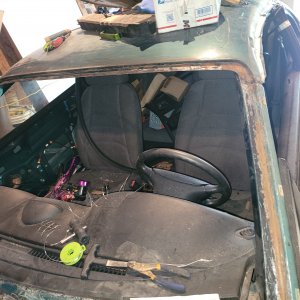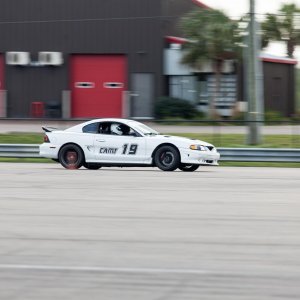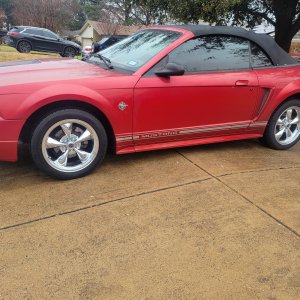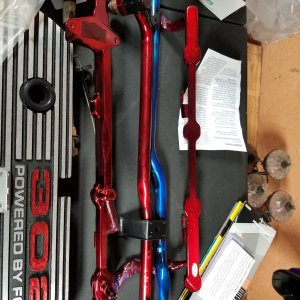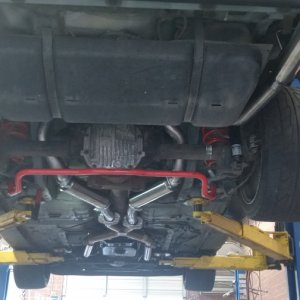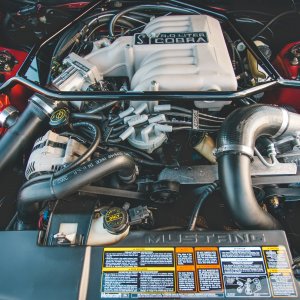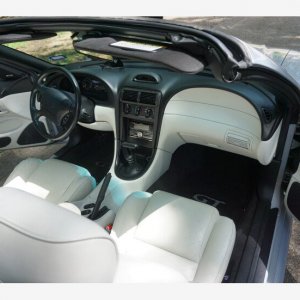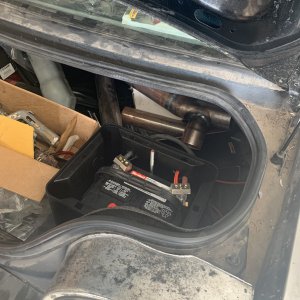Alot of good material here if you have the time to read. Most of you already know, but for someone thats looking to brush up on there Modular history or to leave the pushrods behind this might just be for you.
A Mod Is Born...
Most late-model Ford aficionados mark 1996 as a pivotal year in Mustang evolution because it marked the first time the Modular V-8 was used in a performance application. Some may argue that the '94-95 5.0 GTs were underpowered, but the SN-95 models were superior in ride quality, comfort and handling when compared to earlier Fox Mustangs, and with some simple aftermarket power parts, any SN95 could run with the pack. Then came 1996, and Ford fans watched the beloved 5.0 small-block disappear forever. The replacement displaced a mere 4.6L (or 281 ci). Few considered the "Modular" engine to be a performance V-8, despite the fact that Ford boasted about its many improved traits.
The first Mod engine was used in 1991, when a 4.6 SOHC was placed under the hood of the Lincoln Town Car (even though it was designed for front-drive, east-west applications). Shortly thereafter the 4.6 engine was used in the Crown Victoria, Grand Marquis, Thunderbird, and Cougar. In 1993, Ford released the all-aluminum DOHC 4.6 in the Lincoln Mark VIII, which became the predecessor to the Cobra V-8.
The roots of the Modular movement can be traced back to the late-'80s, to a time when Ford was looking for improved engines for its cars and trucks. While the last pushrod V-8 engines of the mid-'90s provided power and reliability, Ford was looking for a way to improve the overall performance of its engine lineup. This meant smoother-running engines with less noise, vibration, and harshness (NVH), better sealing, lower internal friction, along with increased fuel economy, increased longevity, less maintenance and all without sacrificing power. And let's not forget lower emissions. In addition, Ford engineers wanted an engine family that could share machining procedures and tooling as this would reduce costs.
Marketing also played a larger role in the demise of the 5.0 than you would think. Overhead cam technology was perceived to be more high-tech than pushrods, therefore more marketable. With this in mind, Ford started from scratch with a completely new engine design. The idea was that the basic dimensions could be used to build many different engines and power many different vehicles. Thus, the Modular engine was born.
For starters, Modular blocks are cast from iron (or aluminum in the case of the 1993-01 DOHC engines), and they all feature deep skirting with cross-bolted main caps and lots of webbing. Engine accessories are bolted directly to the engine, which makes for smoother overall operation. All cylinder heads are aluminum and have extra-long head bolts that extend below the cylinder bores into the main cap webs to improve cylinder sealing. Naturally, there are no pushrods, but there are hydraulic roller cam followers that are quiet and require no maintenance.
If there is a downside, it is the lack of displacement. Because of its FWD roots, the tight bore spacing severely limits the size of the piston that can be used in a stock block. Intake manifolds are mounted flat so gaskets aren't squeezed out, reducing the chance of a blown gasket.
Though most folks were opposed to Modular performance at first, we now find lots of people building Modular-powered vehicles. Engine shops are preparing these engines, and customers want the most performance for the lowest price. So now let's take a look at some of the important parts and see what fits.
Modular engines slated for passenger-car use are assembled at the Romeo Engine plant, while the Windsor Engine plant builds the truck engines though some crossover does exist. There are five basic variations of the Modular engine: the SOHC 4.6, DOHC 4.6, SOHC 5.4, DOHC 5.4 (all V-8s) and the 6.8L V-10. All 4.6 engines have a 3.552-inch cylinder bore and 3.543-inch crankshaft stroke, making the engines essentially "square." And while the bore is on the small side, the 4.6 has a favorable rod length-to-stroke ratio. Rather than increasing the bore size, the 5.4 Triton engines gain the extra displacement from a longer 4.16-inch stroke, and the V-10 is essentially a 5.4 with two additional cylinders.
Since 1991, Ford has released many versions of the 4.6L V-8. This means there are different blocks, different cylinder heads, along with some different cams and intakes, too. There are also plenty of interchangeable parts, namely cylinder heads, cranks, and timing assemblies.
All the 4.6 SOHC parts fit from year to year, but you can run into a port alignment problem with the 1996-98 parts and the 1999-up parts. That's because Ford changed the port shape from round to rectangular in 1999. The PI [Power Improved] '99-up heads look identical to the Lightning heads, but the car heads have nine valve cover bolts and the truck heads have 12. You can use either heads on either engine, as long as you use the right valve covers.Most Modular fans are aware of the difference between the 1996-98 engines and the 1999-up engines.
The first Modular engines (1991-98) featured rounded or teardrop-shaped intake ports, and they suffer from intake valve shrouding, and a larger combustion chamber. To remedy the power problem Ford Racing Performance Parts designed a "better" two-valve head with larger ports, reduced intake valve shrouding and a closed combustion chamber. Ironically, in 1999, Ford introduced "Power Improved" (PI) cylinder heads that closely resembled the Ford Racing heads but with rectangular ports and smaller intake valves. The PI heads with matching intake, increased horsepower on the 1999 Mustang GT engine to 260 from its prior rating of 225 in 1998. Any of these heads can be bolted to any 2V or 4V block, as long as the proper intake manifold is used. Keep in mind that putting 1999-up heads on a 1998-earlier engine will increase compression significantly--not a bad thing, but it's something to consider if you're using a power adder.
A Mod Is Born...
Most late-model Ford aficionados mark 1996 as a pivotal year in Mustang evolution because it marked the first time the Modular V-8 was used in a performance application. Some may argue that the '94-95 5.0 GTs were underpowered, but the SN-95 models were superior in ride quality, comfort and handling when compared to earlier Fox Mustangs, and with some simple aftermarket power parts, any SN95 could run with the pack. Then came 1996, and Ford fans watched the beloved 5.0 small-block disappear forever. The replacement displaced a mere 4.6L (or 281 ci). Few considered the "Modular" engine to be a performance V-8, despite the fact that Ford boasted about its many improved traits.
The first Mod engine was used in 1991, when a 4.6 SOHC was placed under the hood of the Lincoln Town Car (even though it was designed for front-drive, east-west applications). Shortly thereafter the 4.6 engine was used in the Crown Victoria, Grand Marquis, Thunderbird, and Cougar. In 1993, Ford released the all-aluminum DOHC 4.6 in the Lincoln Mark VIII, which became the predecessor to the Cobra V-8.
The roots of the Modular movement can be traced back to the late-'80s, to a time when Ford was looking for improved engines for its cars and trucks. While the last pushrod V-8 engines of the mid-'90s provided power and reliability, Ford was looking for a way to improve the overall performance of its engine lineup. This meant smoother-running engines with less noise, vibration, and harshness (NVH), better sealing, lower internal friction, along with increased fuel economy, increased longevity, less maintenance and all without sacrificing power. And let's not forget lower emissions. In addition, Ford engineers wanted an engine family that could share machining procedures and tooling as this would reduce costs.
Marketing also played a larger role in the demise of the 5.0 than you would think. Overhead cam technology was perceived to be more high-tech than pushrods, therefore more marketable. With this in mind, Ford started from scratch with a completely new engine design. The idea was that the basic dimensions could be used to build many different engines and power many different vehicles. Thus, the Modular engine was born.
For starters, Modular blocks are cast from iron (or aluminum in the case of the 1993-01 DOHC engines), and they all feature deep skirting with cross-bolted main caps and lots of webbing. Engine accessories are bolted directly to the engine, which makes for smoother overall operation. All cylinder heads are aluminum and have extra-long head bolts that extend below the cylinder bores into the main cap webs to improve cylinder sealing. Naturally, there are no pushrods, but there are hydraulic roller cam followers that are quiet and require no maintenance.
If there is a downside, it is the lack of displacement. Because of its FWD roots, the tight bore spacing severely limits the size of the piston that can be used in a stock block. Intake manifolds are mounted flat so gaskets aren't squeezed out, reducing the chance of a blown gasket.
Though most folks were opposed to Modular performance at first, we now find lots of people building Modular-powered vehicles. Engine shops are preparing these engines, and customers want the most performance for the lowest price. So now let's take a look at some of the important parts and see what fits.
Modular engines slated for passenger-car use are assembled at the Romeo Engine plant, while the Windsor Engine plant builds the truck engines though some crossover does exist. There are five basic variations of the Modular engine: the SOHC 4.6, DOHC 4.6, SOHC 5.4, DOHC 5.4 (all V-8s) and the 6.8L V-10. All 4.6 engines have a 3.552-inch cylinder bore and 3.543-inch crankshaft stroke, making the engines essentially "square." And while the bore is on the small side, the 4.6 has a favorable rod length-to-stroke ratio. Rather than increasing the bore size, the 5.4 Triton engines gain the extra displacement from a longer 4.16-inch stroke, and the V-10 is essentially a 5.4 with two additional cylinders.
Since 1991, Ford has released many versions of the 4.6L V-8. This means there are different blocks, different cylinder heads, along with some different cams and intakes, too. There are also plenty of interchangeable parts, namely cylinder heads, cranks, and timing assemblies.
All the 4.6 SOHC parts fit from year to year, but you can run into a port alignment problem with the 1996-98 parts and the 1999-up parts. That's because Ford changed the port shape from round to rectangular in 1999. The PI [Power Improved] '99-up heads look identical to the Lightning heads, but the car heads have nine valve cover bolts and the truck heads have 12. You can use either heads on either engine, as long as you use the right valve covers.Most Modular fans are aware of the difference between the 1996-98 engines and the 1999-up engines.
The first Modular engines (1991-98) featured rounded or teardrop-shaped intake ports, and they suffer from intake valve shrouding, and a larger combustion chamber. To remedy the power problem Ford Racing Performance Parts designed a "better" two-valve head with larger ports, reduced intake valve shrouding and a closed combustion chamber. Ironically, in 1999, Ford introduced "Power Improved" (PI) cylinder heads that closely resembled the Ford Racing heads but with rectangular ports and smaller intake valves. The PI heads with matching intake, increased horsepower on the 1999 Mustang GT engine to 260 from its prior rating of 225 in 1998. Any of these heads can be bolted to any 2V or 4V block, as long as the proper intake manifold is used. Keep in mind that putting 1999-up heads on a 1998-earlier engine will increase compression significantly--not a bad thing, but it's something to consider if you're using a power adder.

